Difference between revisions of "Fur - Fur skin"
| (21 intermediate revisions by one user not shown) | |||
| Line 5: | Line 5: | ||
<p align=center> | <p align=center> | ||
| − | [[bild:Dachs-01.jpg| | + | [[bild:Dachs-01.jpg|153px]] |
| − | + | [[bild:Murmeltier-01.jpg|204px]] | |
| − | [[bild:Murmeltier-01.jpg| | + | [[bild:Fuchs-01.jpg|153px]] |
| − | [[bild:Fuchs-01.jpg| | + | |
</p> | </p> | ||
<p align=center> | <p align=center> | ||
| − | ''[[Taxidermy - Hunting trophies - Mounted animals|Mounted animals]]: Badger | + | ''[[Taxidermy - Hunting trophies - Mounted animals|Mounted animals]]: Badger - Marmot - Fox''<br></p> |
<p> </p> | <p> </p> | ||
| + | ==Fur - Pelt - Leather with hair== | ||
| + | Leather can be produced both with and without hair depending on customers' wishes. A [[Hide - Skin|hide]] can have hair or not, whereas a fur or pelt always has hair. A fur is leather with very fine hair. | ||
| − | + | The use of animal [[Hide - Skin|hides]] and furs dates back to early human history. While it was common in the past to use almost any available [[Exotic leather|animal hide]], this has changed over time. In the past, animal hides and furs were used for [[Leather clothing|clothing]], [[leather shoes|shoes]], and other needs. At that time, they were an important resource for people to protect themselves from cold and other elements. Animal hides and furs were acquired by hunters and gatherers who used their skills to hunt animals and process their hides. | |
| − | + | ||
| + | During the 19th century, the demand for furs grew due to increasing prosperity and industrialization. The fur trade flourished, and the fur industry became an important sector of the economy. Most furs came from North America, where fur trapping and trading became a significant part of the economy, but Russia was also known for its furs. | ||
| − | ==Fur - | + | |
| − | Fur is the skin of an animal which has a particularly dense and fine hair (more than 400 hairs per square | + | <p align=center> |
| + | [[bild:Bisam-01.jpg|500px]] | ||
| + | </p> | ||
| + | <p align=center> | ||
| + | [[bild:Bisamfell-01.jpg|500px]] | ||
| + | </p> | ||
| + | <p align=center> | ||
| + | ''Muskrat and muskrat fur.''<br></p> | ||
| + | <p> </p> | ||
| + | |||
| + | In the 20th century, the public attitude towards the use of animal hides and furs began to change. [[Leather sustainability and traceability|Animal welfare]] became an important issue, and more and more people began to speak out against the use of furs for ethical reasons. As a result, the demand for furs decreased. Nowadays, it is much less popular to wear a fur coat or sit on a fur blanket, and the availability of fur items has significantly declined. | ||
| + | |||
| + | [[Sheepskin - Lambskin|Sheepskins and lambskins]], however, have a much higher level of acceptance, as these animals are raised for milk and meat production and not solely for their hides. According to a 2014 study, infants who slept on animal skins during their first three months of life had a 79% reduced risk of developing asthma later on. | ||
| + | |||
| + | |||
| + | ==Fur - Fur skin== | ||
| + | Fur is the skin of an animal which has a particularly dense and fine hair (more than 400 hairs per square centimetre). For example, mink fur, beaver fur, fox fur, sable fur and chinchilla fur etc. Other leather with hair on top is called "skin". | ||
| Line 29: | Line 46: | ||
| − | In 2009 85% of all furs came from breeding animals | + | In 2009 85% of all furs came from breeding animals, most commonly foxes, minks, marten dogs, nutrias and chinchillas. |
| − | In 2013 the turnover in the global fur trade was approx. 15 billion US $. | + | In 2013 the turnover in the global fur trade was approx. 15 billion US $. Around one million people are employed in this sector worldwide. The main production countries are Greece, Russia, China and Denmark. In Germany, the turnover of the fur industry in 2012 was around 1.28 billion euros and there were 23 mink farms. There are about 7,200 fur farms in the EU, mainly in Denmark, the Netherlands, Poland and Finland. About 35 million mink furs and two million fox furs are produced annually in European farms. |
| Line 39: | Line 56: | ||
<p align=center> | <p align=center> | ||
| − | [[bild:Kaninchen-01.jpg| | + | [[bild:Kaninchen-01.jpg|500px]] |
| − | [[bild:Kaenguru-03.jpg| | + | </p> |
| − | [[bild:Marderhund-Fell-01.jpg| | + | <p align=center> |
| + | [[bild:Kaenguru-03.jpg|250px]] | ||
| + | [[bild:Marderhund-Fell-01.jpg|250px]] | ||
</p> | </p> | ||
<p align=center> | <p align=center> | ||
| Line 51: | Line 70: | ||
{| border=1 | {| border=1 | ||
| − | ! width=20% bgcolor=#eeeeee valign=top| | + | ! width=20% bgcolor=#eeeeee valign=top| Animal groups |
| − | ! width=80% bgcolor=#eeeeee valign=top| | + | ! width=80% bgcolor=#eeeeee valign=top| Animal species |
|- | |- | ||
| Line 83: | Line 102: | ||
|- | |- | ||
| − | | bgcolor=#ffffff align=center | | + | | bgcolor=#ffffff align=center | Marten |
| bgcolor=#ffffff align=left | Ermine, weasel, mink, polecat, marten, sable, badger, skunk, otter, wolverine | | bgcolor=#ffffff align=left | Ermine, weasel, mink, polecat, marten, sable, badger, skunk, otter, wolverine | ||
| Line 95: | Line 114: | ||
|- | |- | ||
| − | | bgcolor=#ffffff align=center | | + | | bgcolor=#ffffff align=center | Dogs |
| − | | bgcolor=#ffffff align=left | Wolf, | + | | bgcolor=#ffffff align=left | [[dog leather|Wolf]], coyote, jackal, fox (red fox, silver fox, pole fox and many more), marten dog |
|- | |- | ||
| Line 112: | Line 131: | ||
<p align=center> | <p align=center> | ||
| − | [[bild:Wildkatze-Fell-01.jpg| | + | [[bild:Wildkatze-Fell-01.jpg|500px]] |
| − | [[bild:Fischotter-Fell-01.jpg| | + | </p> |
| − | [[bild:Waschbaer-Fell-01.jpg| | + | <p align=center> |
| + | [[bild:Fischotter-Fell-01.jpg|250px]] | ||
| + | [[bild:Waschbaer-Fell-01.jpg|250px]] | ||
</p> | </p> | ||
<p align=center> | <p align=center> | ||
| Line 121: | Line 142: | ||
<p align=center> | <p align=center> | ||
| − | [[bild:Hermelin-Fell-Sommerkleid-01.jpg| | + | [[bild:Hermelin-Fell-Sommerkleid-01.jpg|500px]] |
| − | [[bild:Hermelin-Fell-Winterkleid-01.jpg| | + | </p> |
| + | <p align=center> | ||
| + | [[bild:Hermelin-Fell-Winterkleid-01.jpg|500px]] | ||
</p> | </p> | ||
<p align=center> | <p align=center> | ||
| − | '' | + | ''Ermine with summer and winter fur.''<br></p> |
<p> </p> | <p> </p> | ||
| − | [[Leather]] is mostly produced from animals that are kept for meat production. This is not the case with fur animals. The meat of [[Goatskin|goats]] and [[Rabbit hair - Rabbit fur|rabbits]] is mostly used for human consumption, but the meat of most of the fur animals is not eaten. In some countries it is even forbidden to eat some of | + | [[Leather]] is mostly produced from animals that are kept for meat production. This is not the case with fur animals. The meat of [[Goatskin|goats]] and [[Rabbit hair - Rabbit fur|rabbits]] is mostly used for human consumption, but the meat of most of the fur animals is not eaten. In some countries, it is even forbidden to eat some of these animals. |
==Furrier== | ==Furrier== | ||
| − | A furrier is a craftsman who processes fur | + | A furrier is a craftsman who processes fur into clothing. This includes repairs and cleaning and care of furs. Due to the declining popularity of fur clothing, the workload and reputation of furriers have greatly decreased. Fur has lost value, is hardly processed anew, and old clothing is rarely altered or repaired because fur is hardly worn anymore. |
| + | |||
| + | However, the furrier's craft still holds its significance. Many furriers specialize in restoring antique furs or processing them into accessories or home textiles. Sheepskins and lambskins are also still in demand. Due to their soft and warm properties, they are commonly used for blankets, rugs, or seat cushions. Overall, the furrier's craft remains an important part of craftsmanship and the history of fur processing, and there will continue to be furriers who master their craft and pass on their art. | ||
<p align=center> | <p align=center> | ||
| − | [[bild:Fur coat 01.jpg| | + | [[bild:Fur coat 01.jpg|500px]] |
| − | + | ||
</p> | </p> | ||
<p align=center> | <p align=center> | ||
| − | ''For the older generation, furs were a sign of prosperity and | + | [[bild:Fur clothing 02.jpg|500px]] |
| + | </p> | ||
| + | <p align=center> | ||
| + | ''For the older generation, furs were a sign of prosperity and provided warmth in the winter.''<br></p> | ||
<p> </p> | <p> </p> | ||
| + | |||
| + | <p align=center> | ||
| + | <flashow>//www.youtube.com/v/x4iEfkchZok&fs=1&color1=0x660000&color2=0x550000&border=1|width=500|height=281,25</flashow> | ||
| + | </p> | ||
| + | <p align=center> | ||
| + | ''The job of a furrier.''</p> | ||
| + | |||
==The cleaning of furs== | ==The cleaning of furs== | ||
| − | In case of soiling, skins or furs can be carefully brushed. Always ask advice from a furrier who is experienced in the cleaning of skins and furs. Specialists use moistened wood chips in a special cleaning process for furs and sensitive skins. Insensitive furs and skins can also be washed with [[Washing and dry cleaning leather|special leather detergents]]. In particular, old skins and furs can be extremely sensitive to | + | In case of soiling, skins or furs can be carefully brushed. Always ask advice from a furrier who is experienced in the cleaning of skins and furs. Specialists use moistened wood chips in a special cleaning process for furs and sensitive skins. Insensitive furs and skins can also be washed with [[Washing and dry cleaning leather|special leather detergents]]. In particular, old skins and furs can be extremely sensitive to wet cleaning and can irreversibly harden and shrink. |
| − | ==Animal protection and | + | <p align=center> |
| + | <flashow>//www.youtube.com/v/EIKB1QAjZYI&fs=1&color1=0x660000&color2=0x550000&border=1|width=500|height=281,25</flashow> | ||
| + | </p> | ||
| + | <p align=center> | ||
| + | ''Fur cleaning and storage.''</p> | ||
| + | |||
| + | |||
| + | <p align=center> | ||
| + | <flashow>//www.youtube.com/v/LcXkEhnA760&fs=1&color1=0x660000&color2=0x550000&border=1|width=500|height=281,25</flashow> | ||
| + | </p> | ||
| + | <p align=center> | ||
| + | ''Cleaning a fur coat.''</p> | ||
| + | |||
| + | |||
| + | ==Animal protection and labelling== | ||
The trade of skins and furs of certain species of animals, particularly those threatened with extinction, has been restricted or prohibited on the basis of [[CITES - Convention on International Trade in Endangered Species of wild fauna and flora|species protection worldwide]]. Many [[PeTA - People for the Ethical Treatment of Animals|animal protectionists]] reject any trade in fur. | The trade of skins and furs of certain species of animals, particularly those threatened with extinction, has been restricted or prohibited on the basis of [[CITES - Convention on International Trade in Endangered Species of wild fauna and flora|species protection worldwide]]. Many [[PeTA - People for the Ethical Treatment of Animals|animal protectionists]] reject any trade in fur. | ||
| − | There is no uniform regulation on the | + | There is no uniform regulation on the labelling of furs. Single EU countries have stricter rules. Since 2008, the Origin Assured (TM) label indicates that fur products come from a country where approved regulations and standards apply to fur production. |
| + | |||
| + | From 01.01.2019 the city of San Francisco in the USA prohibits the sale of furs. The ban applies to [[Leather clothing|clothing]] including [[Leather gloves|gloves]] and accessories. This ban affects about 50 stores and approximately $ 40 million in sales. | ||
| + | |||
| + | |||
| + | <p align=center> | ||
| + | [[bild:Anti-fur-01.jpg|500px]] | ||
| + | </p> | ||
| + | <p align=center> | ||
| + | ''The [[PeTA - People for the Ethical Treatment of Animals|opponents of furs]] often drastically draw attention to their concerns.''<br></p> | ||
| + | <p> </p> | ||
| Line 157: | Line 215: | ||
<p align=center> | <p align=center> | ||
| − | <flashow> | + | <flashow>//www.youtube.com/v/KGYUDNJG_qY&fs=1&color1=0x660000&color2=0x550000&border=1|width=500|height=281,25</flashow> |
</p> | </p> | ||
<p align=center> | <p align=center> | ||
| Line 164: | Line 222: | ||
<p align=center> | <p align=center> | ||
| − | <flashow> | + | <flashow>//www.youtube.com/v/fUufawOqoKA&fs=1&color1=0x660000&color2=0x550000&border=1|width=500|height=281,25</flashow></p> |
| − | </p> | + | |
<p align=center> | <p align=center> | ||
| − | '' | + | ''The [[tanning]] of haired skins with simple means.'' |
| + | </p> | ||
<p align=center> | <p align=center> | ||
| − | <flashow> | + | <flashow>//www.youtube.com/v/IJ_OscoWeyc&fs=1&color1=0x660000&color2=0x550000&border=1|width=500|height=281,25</flashow> |
</p> | </p> | ||
<p align=center> | <p align=center> | ||
''How to make fur blankets.''</p> | ''How to make fur blankets.''</p> | ||
| − | |||
| − | |||
| − | |||
| Line 201: | Line 256: | ||
<p align=center> | <p align=center> | ||
| − | [[bild:Zebra-Fell-01.jpg| | + | [[bild:Zebra-Fell-01.jpg|500px]] |
| − | + | ||
</p> | </p> | ||
<p align=center> | <p align=center> | ||
| − | ''[[Zebra hide]] and [[Bison hide]]''<br></p> | + | [[bild:Bisonfell-01.jpg|500px]] |
| + | </p> | ||
| + | <p align=center> | ||
| + | ''[[Zebra hide]] and [[Bison leather|bison hide]].''<br></p> | ||
<p> </p> | <p> </p> | ||
<p align=center> | <p align=center> | ||
| − | [[bild:Alpakafell-01.jpg| | + | [[bild:Alpakafell-01.jpg|500px]] |
| − | [[bild:Alpakafell-02.jpg| | + | </p> |
| + | <p align=center> | ||
| + | [[bild:Alpakafell-02.jpg|500px]] | ||
</p> | </p> | ||
<p align=center> | <p align=center> | ||
| − | ''Wonderful warm [[Alpaca fur & Llama fur|Alpaca]] slippers from Lima in | + | ''Wonderful warm [[Alpaca fur & Llama fur|Alpaca]] slippers from Lima in Peru. - [[Alpaca fur & Llama fur|Alpaca fur]]-[[Leather accessories|accessories]] of the market in Aguas Calientes, Peru, below Machu Picchu.''<br></p> |
<p> </p> | <p> </p> | ||
| Line 225: | Line 284: | ||
<p align=center> | <p align=center> | ||
| − | [[bild:kuhfell-gefaerbt-001.jpg| | + | [[bild:kuhfell-gefaerbt-001.jpg|500px]] |
| − | [[bild:Kuhfell-Zebra-Tiger-Muster.jpg| | + | </p> |
| + | <p align=center> | ||
| + | [[bild:Kuhfell-Zebra-Tiger-Muster.jpg|500px]] | ||
</p> | </p> | ||
<p align=center> | <p align=center> | ||
| Line 241: | Line 302: | ||
<p align=center> | <p align=center> | ||
| − | [[bild:Fellmütze-04.jpg| | + | [[bild:Fellmütze-04.jpg|500px]] |
| − | + | ||
</p> | </p> | ||
<p align=center> | <p align=center> | ||
| − | ''[[Leather hat|Fur hats]] in | + | [[bild:Fellmütze-03.jpg|500px]] |
| + | </p> | ||
| + | <p align=center> | ||
| + | ''[[Leather hat|Fur hats]] in Moscow.''<br></p> | ||
<p> </p> | <p> </p> | ||
| − | |||
| − | |||
| − | |||
| − | |||
== Additional information == | == Additional information == | ||
Latest revision as of 07:58, 5 May 2023
Mounted animals: Badger - Marmot - Fox
Contents
Fur - Pelt - Leather with hair
Leather can be produced both with and without hair depending on customers' wishes. A hide can have hair or not, whereas a fur or pelt always has hair. A fur is leather with very fine hair.
The use of animal hides and furs dates back to early human history. While it was common in the past to use almost any available animal hide, this has changed over time. In the past, animal hides and furs were used for clothing, shoes, and other needs. At that time, they were an important resource for people to protect themselves from cold and other elements. Animal hides and furs were acquired by hunters and gatherers who used their skills to hunt animals and process their hides.
During the 19th century, the demand for furs grew due to increasing prosperity and industrialization. The fur trade flourished, and the fur industry became an important sector of the economy. Most furs came from North America, where fur trapping and trading became a significant part of the economy, but Russia was also known for its furs.
Muskrat and muskrat fur.
In the 20th century, the public attitude towards the use of animal hides and furs began to change. Animal welfare became an important issue, and more and more people began to speak out against the use of furs for ethical reasons. As a result, the demand for furs decreased. Nowadays, it is much less popular to wear a fur coat or sit on a fur blanket, and the availability of fur items has significantly declined.
Sheepskins and lambskins, however, have a much higher level of acceptance, as these animals are raised for milk and meat production and not solely for their hides. According to a 2014 study, infants who slept on animal skins during their first three months of life had a 79% reduced risk of developing asthma later on.
Fur - Fur skin
Fur is the skin of an animal which has a particularly dense and fine hair (more than 400 hairs per square centimetre). For example, mink fur, beaver fur, fox fur, sable fur and chinchilla fur etc. Other leather with hair on top is called "skin".
In 2009 85% of all furs came from breeding animals, most commonly foxes, minks, marten dogs, nutrias and chinchillas.
In 2013 the turnover in the global fur trade was approx. 15 billion US $. Around one million people are employed in this sector worldwide. The main production countries are Greece, Russia, China and Denmark. In Germany, the turnover of the fur industry in 2012 was around 1.28 billion euros and there were 23 mink farms. There are about 7,200 fur farms in the EU, mainly in Denmark, the Netherlands, Poland and Finland. About 35 million mink furs and two million fox furs are produced annually in European farms.
Animal species for fur and skins with hair
There are many animal species and their subspecies, from which furs or skins are made. There are unprotected animals and protected animals. The following list contains a lot of animals used to produce fur and skins with hair, but it`s not complete.
Rabbit - Kangaroo - Marten dog
The different animal species for fur and skin production
| Animal groups | Animal species |
|---|---|
| Poultry animals | Opossum, Wallaby, Kangaroo |
| Hare species | Snow rabbit, wild rabbit, domestic rabbit (Chinchilla and many more breeding varieties) |
| Primates | She-monkey |
| Cloven hoofed animals | Guanako (young animal), vicuna, goats (young animal), domestic goat, domestic sheep (Persian, Merinos and many other species, often lambs), springbok, calves (from cattle), reindeer |
| Unpaired hoofed animals | Foal (horse), zebra |
| Insectivorous | Mole, silver bisam |
| Rodents | Ground squirrel, bamboo rat, marmot, squirrel, beaver, hamster, bisam, nutria, chinchilla, viscacha |
| Marten | Ermine, weasel, mink, polecat, marten, sable, badger, skunk, otter, wolverine |
| Bears | Black bear, polar bear, brown bear |
| Small bears | Catfry, raccoon |
| Dogs | Wolf, coyote, jackal, fox (red fox, silver fox, pole fox and many more), marten dog |
| Cats | Cats (domestic cats, wild cats and other species), lion, cougar, lynx, serval, cheetah, ocelot, jaguar, leopard, tiger |
| Water animals | Seal |
Wild cat - Fish Otter - Raccoon
Ermine with summer and winter fur.
Leather is mostly produced from animals that are kept for meat production. This is not the case with fur animals. The meat of goats and rabbits is mostly used for human consumption, but the meat of most of the fur animals is not eaten. In some countries, it is even forbidden to eat some of these animals.
Furrier
A furrier is a craftsman who processes fur into clothing. This includes repairs and cleaning and care of furs. Due to the declining popularity of fur clothing, the workload and reputation of furriers have greatly decreased. Fur has lost value, is hardly processed anew, and old clothing is rarely altered or repaired because fur is hardly worn anymore.
However, the furrier's craft still holds its significance. Many furriers specialize in restoring antique furs or processing them into accessories or home textiles. Sheepskins and lambskins are also still in demand. Due to their soft and warm properties, they are commonly used for blankets, rugs, or seat cushions. Overall, the furrier's craft remains an important part of craftsmanship and the history of fur processing, and there will continue to be furriers who master their craft and pass on their art.
For the older generation, furs were a sign of prosperity and provided warmth in the winter.
The job of a furrier.
The cleaning of furs
In case of soiling, skins or furs can be carefully brushed. Always ask advice from a furrier who is experienced in the cleaning of skins and furs. Specialists use moistened wood chips in a special cleaning process for furs and sensitive skins. Insensitive furs and skins can also be washed with special leather detergents. In particular, old skins and furs can be extremely sensitive to wet cleaning and can irreversibly harden and shrink.
Fur cleaning and storage.
Cleaning a fur coat.
Animal protection and labelling
The trade of skins and furs of certain species of animals, particularly those threatened with extinction, has been restricted or prohibited on the basis of species protection worldwide. Many animal protectionists reject any trade in fur.
There is no uniform regulation on the labelling of furs. Single EU countries have stricter rules. Since 2008, the Origin Assured (TM) label indicates that fur products come from a country where approved regulations and standards apply to fur production.
From 01.01.2019 the city of San Francisco in the USA prohibits the sale of furs. The ban applies to clothing including gloves and accessories. This ban affects about 50 stores and approximately $ 40 million in sales.
The opponents of furs often drastically draw attention to their concerns.
Video about furs
Fur production.
The tanning of haired skins with simple means.
How to make fur blankets.
Hides with hair on top
Skin on which the hair is still present, is referred to as fur or skin. Typical terms for skins are lion's skin, sheepskin, cowhide, bearskin etc.
According to a study from 2014, children who have slept on animal fur or hides during the first three months of life have a 79% reduced risk of developing asthma later.
Head of leopard fur. - Bear skin.
Zebra hide and bison hide.
Wonderful warm Alpaca slippers from Lima in Peru. - Alpaca fur-accessories of the market in Aguas Calientes, Peru, below Machu Picchu.
Goat- and wild boar skin.
Exotic dyed cow and calf skins.
Skins as covers on car seats.
Fur hats in Moscow.
Additional information
- Taxidermy - Hunting trophies - Mounted animals
- Exotic leather
- CITES - Convention on International Trade in Endangered Species of wild fauna and flora
- PeTA - People for the Ethical Treatment of Animals
- Dorsal stripe
- Cow hide
- Sheepskin - Lambskin
- Sealskin leather
- Beaver fur
- Rabbit hair - Rabbit fur
- Alpaca fur & Llama fur








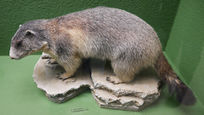
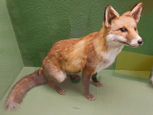
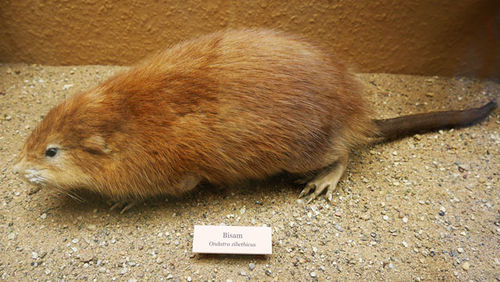
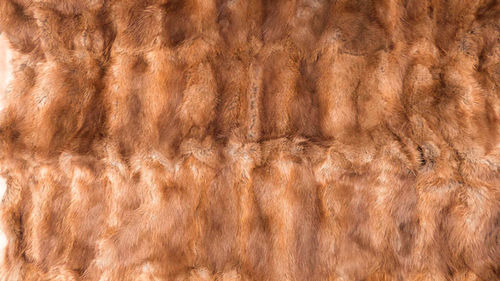

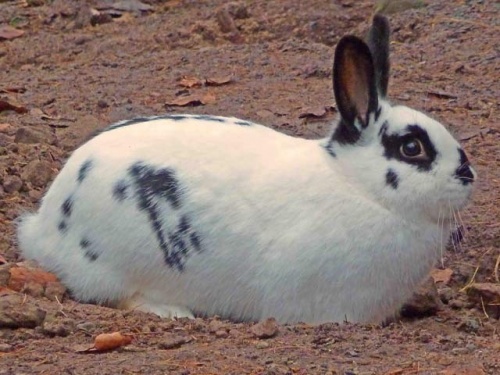
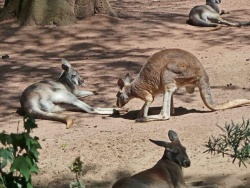

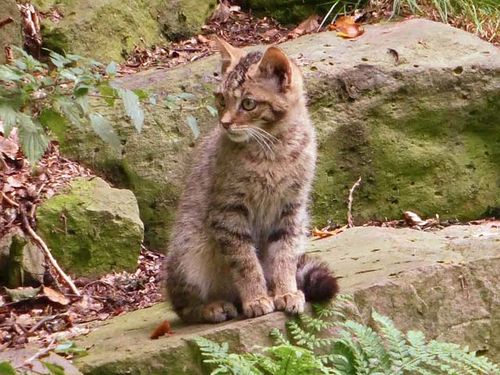
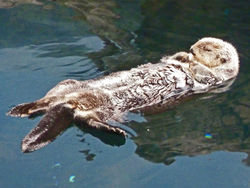
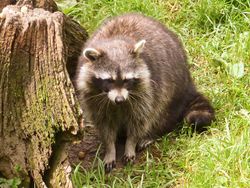
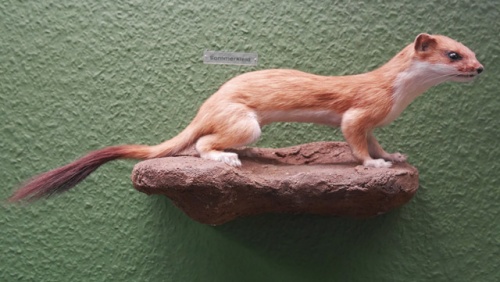

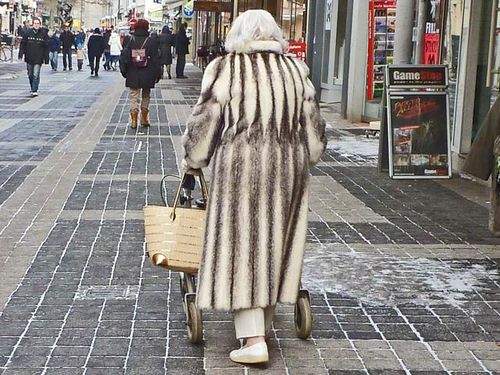
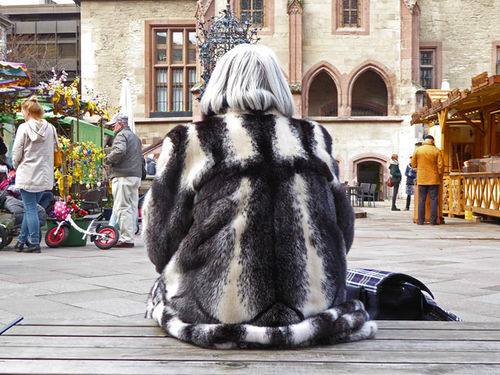

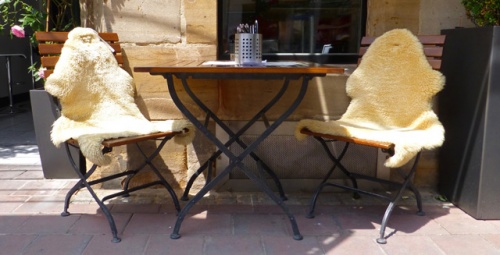
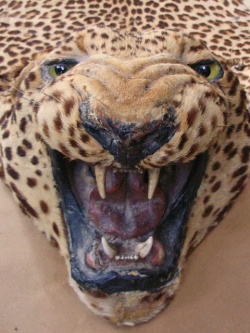
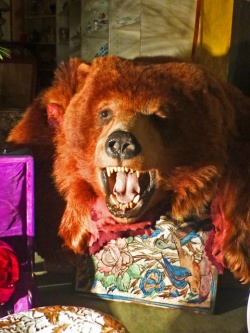
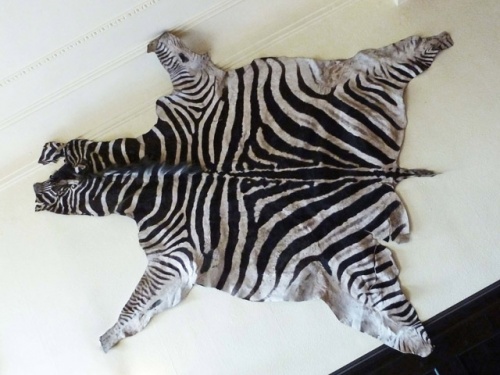
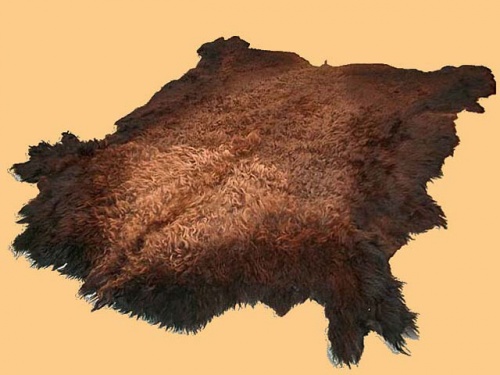
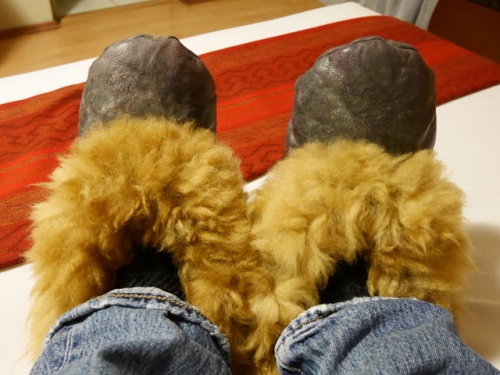
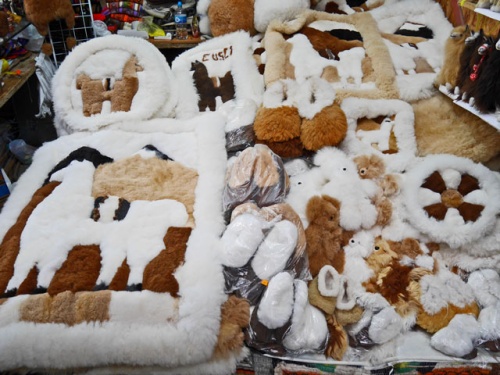
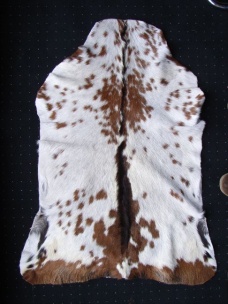
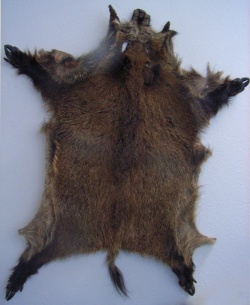
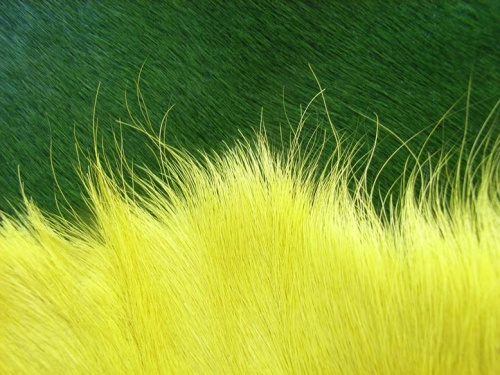
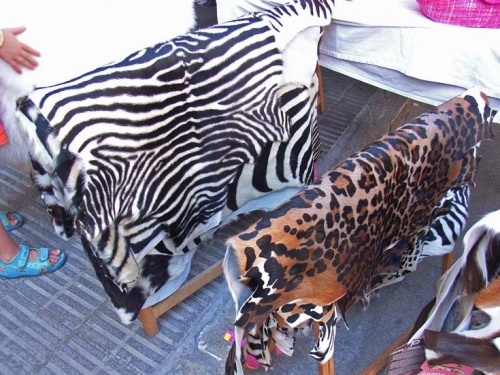
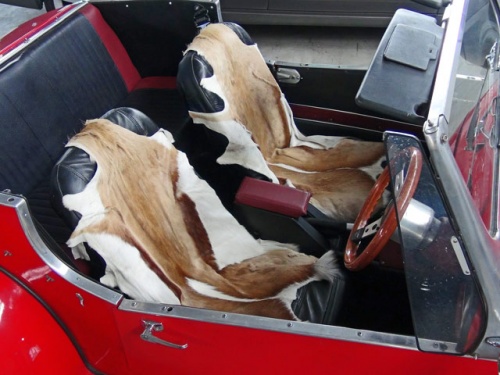
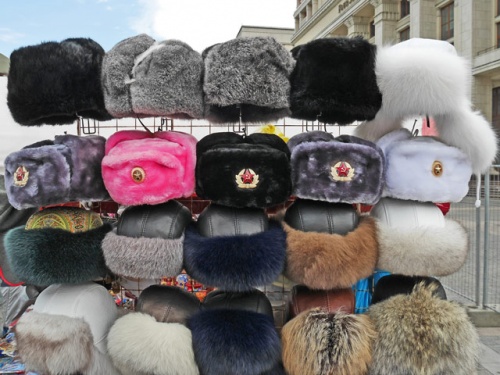
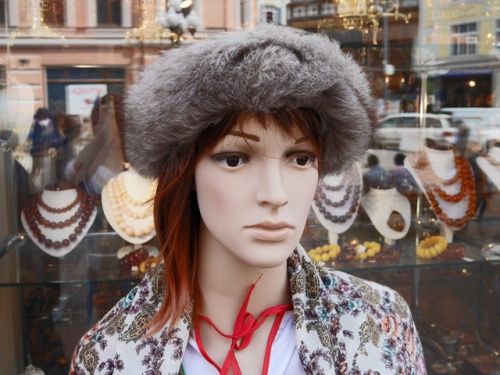

 a kotori web solution
a kotori web solution